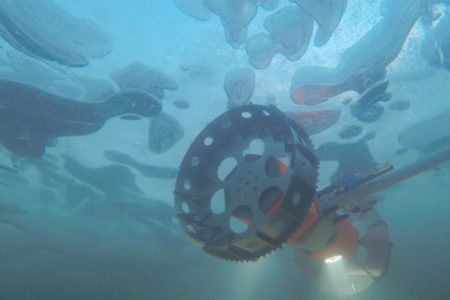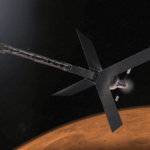April 4, 2020 – In November of last year, NASA launched the Buoyant Rover for Under-Ice Exploration (BRUIE) in Antarctica to test the design for a potential future Ice World-Ocean World mission. The worlds BRUIE is intended to explore could include Europa, Ganymede, Enceladus, Titan, and Triton.
BRUIE is designed to survive under the surface of ice-covered oceans. It operates untethered and autonomously and will carry an instrumentation package on board to measure the chemical composition of liquid environments. In initial tests conducted by Jet Propulsion Laboratory (JPL), first in Arctic Alaska, and now in Antarctica in November, BRUIE has been lowered into its ice-ocean world through holes that had to be drilled. BRUIE, a joint development by JPL and the University of Western Australia’s School of Engineering, has buoyancy, allowing it to cling to the underside of ice layers where it uses its two drive-independent wheels.
What do you find when you cling to the underside of polar sea ice here on Earth?
The undersurface of sea ice is a rich habitat for bacteria, viruses, unicellular algae, and small invertebrates. Many reside in the network of fine cracks that form passages for nutrients and light to penetrate. When sea ice forms on Earth’s polar oceans, the salt leaches out and concentrates on the underside eventually inhibiting formation of additional ice. Organisms have adapted to the concentration of salt using its natural antifreeze properties along with organic defenses which so many polar creatures have evolved to survive in these harsh conditions.
Astrobiologists have been studying the capability of polar organisms to exist in extreme conditions. Called extremophiles, they are an analog for what may be found in the ice moons to which BRUIE could be sent. But getting BRUIE to transit the underside of icy surfaced moons comes with challenges greater than just making a landing. The subterranean oceans of these worlds lie well below their icy surfaces that are in some cases tens of kilometers thick. The search to find suitable landing places where natural vents to the subsurface ocean exist will be a priority for any future mission. Without a natural entry any mission undertaken will have to add drilling equipment capable of creating a hole large and deep enough for BRUIE to make the descent.
Are such endeavours worth the effort?
Finding life on the moons of the Outer Solar System would be a shattering discovery for biologists. The Goldilocks Zone around a star where life could exist will be dramatically expanded. And scientists with almost absolute certainty believe that among these target moons are ocean worlds that could harbour life. The evidence of subterranean oceans exists aplenty. Here is a list of some of what planetary scientists have discovered:
- Images of Saturn’s moon, Enceladus, show upwellings of geysers spewing salty water from the surface into space. When Cassini flew over the vents spewing the water into space, it detected organic molecules. On Earth, we know that organic molecules are precursors to the existence of life.
- Galileo provided evidence of the ocean beneath Europa’s icy crust as well as measuring deposits of organic molecules on the moon’s icy surface. The chaotic surface terrain appeared to be melting and freezing continuously. Such conditions would indicate a mixing of materials deposited on the surface with ocean water beneath, a potential source of nutrition for existing microorganisms. The repeated melting and freezing could form cracks needed for BRUIE to make a descent. They also could allow surface light to reach areas of the ocean for photosynthesis. Another theory speculates that Europa’s oceans feature blobs like those found in a lava lamp, rising through the water column when warmed by the continuous exertion of Jupiter’s gravity. Such upwellings could carry organic material including microorganisms from the depths to the surface where interaction with oxidants produced by solar radiation would provide sustenance. Whichever model is correct, Europa is a strong candidate for harbouring life that a future BRUIE could detect.
- Ganymede, Jupiter’s largest moon and bigger than Mercury, is another candidate. Its surface geology indicates a significant subsurface ocean.
- Titan, Saturn’s largest moon, features methane-filled lakes but beneath them is an ice world with a subterranean ocean.
- And then there is Triton whose images were captured by Voyager 2 as it flew past Neptune. Triton’s terrain strongly suggests a hidden ocean. Pictures show plumes of material rising into space similar to what has been observed at Enceladus and Europa. There are also surface streaks of deposits which appear to have been laid down by past and present eruptions.
Sometime in the 2020s, should we all survive COVID-19, NASA plans to launch a mission to study Europa. It will orbit Jupiter and perform numerous flybys of Europa. Plans for a lander are under consideration. But no BRUIE will be onboard then. That will probably happen as much as a decade later unless the Europa flybys and landing find evidence of potential life to speed up the planning.
















